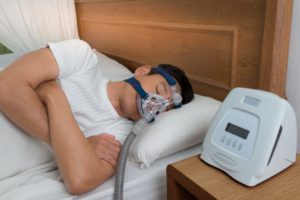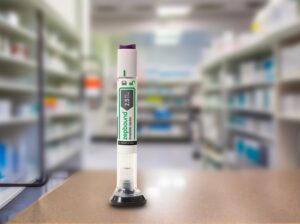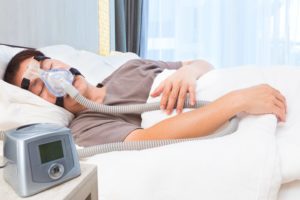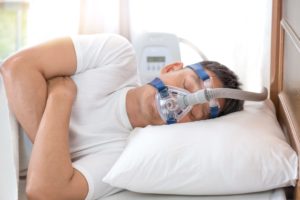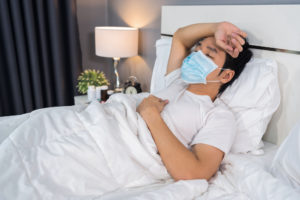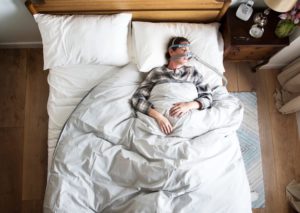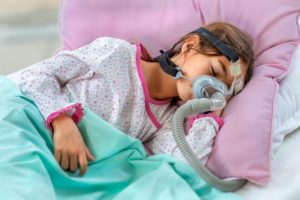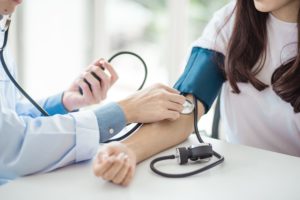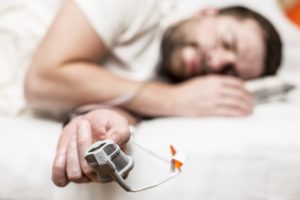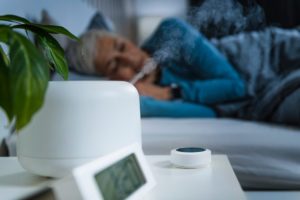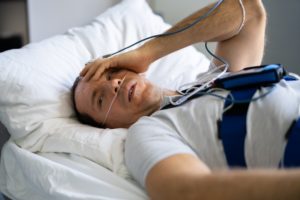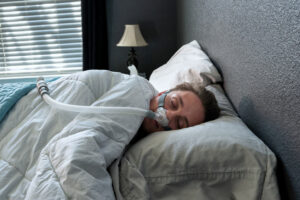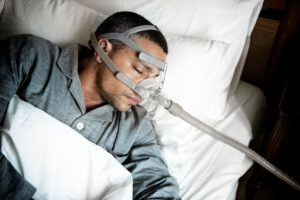When you buy through our links, we may earn a commission. Products or services may be offered by an affiliated entity. Learn more.
Hypercapnia
- Hypercapnia refers to an excessive level of carbon dioxide (CO2) in the bloodstream.
- Repeated interruptions in breathing due to sleep apnea can contribute to hypercapnia.
- Hypercapnia can cause headaches, confusion, shortness of breath, and increase heart rate.
- Over time it can lead to respiratory problems, heart issues, and neurological complications.
- Treatment typically focuses on underlying causes and may involve PAP therapy, lifestyle changes, or surgery to improve breathing during sleep.
Hypercapnia is a term used to describe too much carbon dioxide in the bloodstream, which can lead to headaches, fatigue, and potentially serious complications.
For some people, hypercapnia develops rather suddenly, for example if the person stops breathing. Other times, hypercapnia can be a sign of an ongoing health issue, such as chronic obstructive pulmonary disease (COPD). Hypercapnia can also occur as a result of sleep apnea, a sleep-related breathing disorder.
We take a closer look at what causes hypercapnia, how to prevent and treat hypercapnia, and when to visit a doctor.
Think You May Have Sleep Apnea? Get Help Today

our partner at sleepdoctor.com
10% off Home Sleep Tests
Buy Now“Truly grateful for this home sleep test. Fair pricing and improved my sleep!”
Dawn G. – Verified Tester
What Is Hypercapnia?
Hypercapnia, also known as hypercarbia , occurs when the concentration of carbon dioxide (CO2) in the bloodstream rises above a certain level. This can upset the acid-base balance in the bloodstream and cause a range of mild to severe symptoms. Hypercapnia is considered a sign of a larger issue instead of being a standalone disease. It can occur suddenly, or it can exist in chronic form.
What Are the Symptoms of Hypercapnia?
Hypercapnia symptoms can vary in severity, and they may present differently depending on the underlying issue. Some common symptoms of hypercapnia are:
- Labored or shallow breathing
- Wheezing
- Altered consciousness or confusion
- Fever
- Flushed skin
- Sweating profusely
- Fatigue or sleepiness
- Headache or nausea
- Irritability
Many of these symptoms are also symptoms of other diseases. Additionally, hypercapnia often (but not always) occurs along with a lack of oxygen. If you are experiencing any of these symptoms, contact your doctor.
What Causes Hypercapnia?
Hypercapnia occurs when the blood’s CO2 level rises above normal due to respiratory problems, excessive metabolism, or more rarely, from breathing in too much CO2.
The body produces CO2 as a byproduct of metabolism. Some examples of events that can trigger higher-than-usual CO2 production are fever, steroid use, eating too much, and exercise. Usually, we regulate CO2 levels by breathing in and out. However, excessive production of CO2 coupled with a compromised respiratory system may lead to higher levels of CO2 in the body.
Severe breathing problems that interfere with a person’s ability to regulate levels of oxygen and CO2 are known as ventilatory failure . Ventilatory failure can arise through illnesses such as asthma, COPD, drug overdose, or physical issues with the respiratory system. Diseases that cause a weakening of the muscles required for breathing, such as Guillain-Barré syndrome, can also cause hypercapnia .
Sleep Apnea and Hypercapnia
One condition that can cause hypercapnia at night is sleep apnea , a disorder in which a person stops breathing multiple times during sleep. These breathing lapses are most often caused by a physical obstruction of the airway, termed obstructive sleep apnea. They can also result from a problem in the brain’s signals to the respiratory system, termed central sleep apnea . Both types of sleep apnea contribute to unrefreshing sleep.
The obstruction in breathing from sleep apnea can also cause hypercapnia during the waking hours. One study found that 14% of people with obstructive sleep apnea also experienced hypercapnia during the day .
Additionally, a related condition called obesity hypoventilation syndrome can cause hypercapnia. People with obesity hypoventilation syndrome may start out experiencing breathing problems during sleep, and eventually progress to experiencing hypercapnia during the day as well.
How Is Hypercapnia Diagnosed?
To diagnose hypercapnia, doctors usually run an arterial blood gas analysis to check for abnormally high levels of carbon dioxide in your blood. During the test, your doctor will draw blood from an artery . This may be more uncomfortable than a regular blood draw.
If your blood sample reveals high levels of CO2, your doctor will also check to see if your blood is acidic. This can provide information about whether the hypercapnia is short-term or chronic. Short-term CO2 spikes raise blood acidity, but people with chronic hypercapnia often have neutral acidity levels because they have developed mechanisms to compensate for this chemical in the blood.
Because hypercapnia usually stems from an underlying condition, your doctor may need to run multiple additional tests to check your thyroid hormone levels, lung and heart functioning, and other parameters. If they suspect your hypercapnia could be due to sleep apnea, they may perform an overnight sleep test, called polysomnography. They will also ask you questions about your medical history.
How Is Hypercapnia Treated?
Treatment for hypercapnia is generally directed at treating the underlying problem.
If your hypercapnia is due to chronic obstructive pulmonary disease , your doctor may ask you to limit your exposure to smoke and prescribe medications. If you have obstructive sleep apnea, lifestyle changes such as quitting smoking, losing weight if you are overweight, and avoiding alcohol and sedatives before bedtime may ease symptoms.
For hypercapnia that is exacerbated by medication , ask your doctor about lowering doses or switching medications. People with severe lung problems may be referred for lung volume reduction surgery to improve breathing.
Breathing Machines
If you are struggling with moderate or severe hypercapnia, your doctor may recommend a device to help you breathe. Often, the first type of device they will try is a continuous positive airway pressure (CPAP) or bi-level positive airway pressure (BiPAP) device. These consist of face masks that deliver a stream of slightly pressurized air to keep the airway open, helping the body naturally remove the extra CO2. This type of ventilation usually improves symptoms within a few hours, although nightly CPAP therapy can also be used long-term by people with obstructive sleep apnea.
A more invasive alternative to CPAP and BiPAP therapy is intubation with mechanical ventilation, in which a tube is inserted into the windpipe and a machine pushes air in and out of the lungs . This technique usually resolves hypercapnia within a few hours, though people with conditions such as asthma or pneumonia may require a few days before CO2 levels return to normal.
To protect the lungs from damage due to mechanical ventilation, doctors may set the air pressure slightly lower than it needs to be, meaning the hypercapnia takes a little longer to resolve. This technique is known as permissive hypercapnia.
If none of these artificial ventilation techniques work, there is a newer treatment called extracorporeal carbon dioxide removal that is designed to siphon out carbon dioxide from the blood instead of through the airways. Your doctor may try this technique if it is available in your area.
When to See a Doctor
You should talk to your doctor if you have severe hypercapnia symptoms, if you have had mild hypercapnia symptoms for several days, if they are accompanied by other symptoms, or if you have any other reason to be worried for your health. It is important to find and treat the cause of your hypercapnia to reduce the risk of complications.

Still have questions? Ask our community!
Join our Sleep Care Community — a trusted hub of sleep health professionals, product specialists, and people just like you. Whether you need expert sleep advice for your insomnia or you’re searching for the perfect mattress, we’ve got you covered. Get personalized guidance from the experts who know sleep best.
References
13 Sources
-
Rawat, D., Modi, P., & Sharma, S. (2021). Hypercapnea [sic]. In StatPearls. StatPearls Publishing.
https://pubmed.ncbi.nlm.nih.gov/29763188/ -
Chapman, K., & Dragan, K. E. (2021). Hypercarbia. In StatPearls. StatPearls Publishing.
https://pubmed.ncbi.nlm.nih.gov/32644580/ -
Patel, B. (2020, May). Ventilatory failure. Merck Manual Professional Version., Retrieved August 29, 2021, from
https://www.merckmanuals.com/professional/critical-care-medicine/respiratory-failure-and-mechanical-ventilation/ventilatory-failure -
Nayak R. (2017). Practical approach to the patient with acute neuromuscular weakness. World Journal of Clinical Cases, 5(7), 270–279.
https://pubmed.ncbi.nlm.nih.gov/28798922/ -
Strohl, K. P. (2020, September). Sleep apnea. Merck Manual Consumer Version., Retrieved August 29, 2021, from
https://www.merckmanuals.com/home/lung-and-airway-disorders/sleep-apnea/sleep-apnea -
A.D.A.M. Medical Encyclopedia. (2021, July 12). Central sleep apnea. MedlinePlus., Retrieved August 29, 2021, from
https://medlineplus.gov/ency/article/003997.htm -
Kawata, N., Tatsumi, K., Terada, J., Tada, Y., Tanabe, N., Takiguchi, Y., & Kuriyama, T. (2007). Daytime hypercapnia in obstructive sleep apnea syndrome. Chest, 132(6), 1832–1838.
https://pubmed.ncbi.nlm.nih.gov/18079218/ -
Sivam, S., Yee, B., Wong, K., Wang, D., Grunstein, R., & Piper, A. (2018). Obesity hypoventilation syndrome: Early detection of nocturnal-only hypercapnia in an obese population. Journal of Clinical Sleep Medicine: JCSM: Official Publication of the American Academy of Sleep Medicine, 14(9), 1477–1484.
https://pubmed.ncbi.nlm.nih.gov/30176974/ -
U.S. National Library of Medicine. (2020, December 2). Blood oxygen level., Retrieved September 28, 2021, from
https://medlineplus.gov/lab-tests/blood-oxygen-level/ -
Centers for Disease Control and Prevention. (2020, September). COPD: Symptoms, diagnosis, and treatment., Retrieved August 31, 2021, from
https://www.cdc.gov/copd/index.html -
Steynor, M., & MacDuff, A. (2015). Always consider the possibility of opioid induced respiratory depression in patients presenting with hypercapnic respiratory failure who fail to improve as expected with appropriate therapy. Case Reports in Critical Care, 2015, 562319.
https://pubmed.ncbi.nlm.nih.gov/25893118/ -
National Heart, Lung, and Blood Institute. (2022, March 24). What is COPD?.
https://www.nhlbi.nih.gov/health-topics/copd -
Patel, B.K. (2020, April). Mechanical ventilation. Merck Manual Consumer Version., Retrieved August 29, 2021, from
https://www.msdmanuals.com/home/lung-and-airway-disorders/respiratory-failure-and-acute-respiratory-distress-syndrome/mechanical-ventilation






